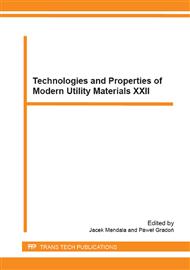p.49
p.53
p.59
p.65
p.69
p.75
p.79
p.87
p.91
Fatigue Behaviour of Carbide Precipitation Hardened Austenitic Steels
Abstract:
The paper presents the results of investigations of the microstructure and fatigue behaviour of two newly invented Cr-Ni and Cr-Ni-Mn austenitic steels of 13/13 and 12/8/8 type strengthened through carbide particle precipitation. The specimens of the investigated steels were subjected to tests after heat treatment, i.e. solution heat treatment (1200°C/0.5 h/water) and aged at a temperature of 700°C for 12 h, with cooling in air. The heat treated specimens were then subjected to low-cycle fatigue tests (LCF), carried out at room temperature and at an increased temperature of 600°C. Diagrams of fatigue characteristics of the investigated steels at room temperature as well as at elevated temperature have been worked up. It has been found that during low-cycle fatigue tests, at both temperatures, the investigated austenitic steels indicated a fatigue softening effect. The results of LCF at room temperature showed that the fatigue durability (Nt) of both austenitic steels is located in the range 0.8÷1.3×103 cycles. The results of low-cycle fatigue tests at an increased temperature 600°C indicated that the fatigue durability of the investigated steel was lower, and is located in the range Nt = 0.5÷0.6×103 cycles. It has been pointed out that the investigated austenitic steels are characterized by a stability of structure in conditions of cyclic fatigue.
Info:
Periodical:
Pages:
69-74
Citation:
Online since:
January 2015
Authors:
Price:
Сopyright:
© 2015 Trans Tech Publications Ltd. All Rights Reserved
Share:
Citation:


